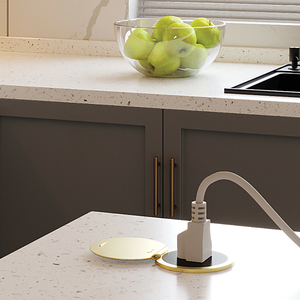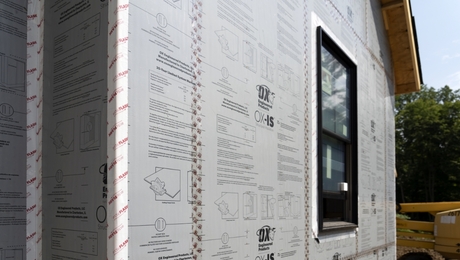The Performance Paths to the Energy Codes
By considering things like energy-efficient mechanicals, window orientation, and renewable energy sources, homes can be evaluated to meet the energy codes. Here's what the IRC has to say.

In last issue’s Know the Code, I explained how the energy conservation provisions found in Chapter 11 of the International Residential Code (IRC) provide options for designers and builders when it comes to energy code compliance. I compared the options offered in the IRC to the many paths I could drive from my house to the store—to get from here to there, I can choose from several routes that vary in time, cost, and effort. Since energy codes were introduced in the 1970s, they’ve provided different ways to design and build a home’s thermal envelope to provide for conservation, as well as other methods of creating effective use of energy that are all sufficient to meet the performance goals established by the International Code Council. Though there have always been options, the options have evolved.
The “prescriptive” methods for energy code compliance (including the R-value alternative, U-factor computation, and UA alternative) were explained in the previous issue. These straightforward requirements outlined in the IRC are generally simpler methods than the compliance paths I’ll discuss here. In this issue I’ll explain the performance path and the Energy Rating Index, or ERI, but only a basic overview. That’s because these methods require third-party evaluations and significantly more detail about the house’s design, location, orientation, equipment, airtightness, on-site energy generation, and more to be evaluated for energy code compliance. While they may require more detailed information and the work of third-party professionals, they also offer much more design flexibility and choice.
No matter which path you take to energy code compliance, the 2021 IRC includes a section of “additional efficiency package options.” Here designers and builders face another set of choices. I will discuss this section of the energy code in this issue as well.
The Performance Method Considers Energy Costs
When measuring the results of something, you need to have a metric for comparison. For my route to the retail store, the metric of success is whether I arrived. But when measuring the path of energy code compliance, there is no physical destination. In the prescriptive path and options, the metrics are R-value and U-factor. These are standardized measures that can be used to compare the conservation of energy of different designs. The performance method (section N1105), one of the original compliance options dating back to the ’70s, uses a different metric: money.
Consider that if energy didn’t cost money, and was readily and abundantly available, we likely wouldn’t be concerned with its effective use and conservation. Because energy isn’t free, we can use the annual energy costs for a building as a standardized regional metric for evaluating energy use and energy conservation. Remember, the intent of the energy code is not to directly reduce energy usage, but to keep you from wasting it. A code-compliant 1000-sq.-ft. home will use less energy than a code-compliant 10,000-sq.-ft. home. In other words, nothing in the energy code provides a universal limit to energy usage in buildings. Energy code compliance is always proportional to the size of the building.
The total UA method (explained in the previous issue) uses software to compare the sum of U-factors of a proposed design’s unique building assemblies with required U-factors of generic assemblies given in the IRC. If the proposed design’s total U-factor is equal or less than the generic design total, the design is compliant. In the same way, the performance method is a comparative analysis, with all its details found in IRC section N1105. The type and area of each assembly of the building thermal envelope is entered into software approved by the building official and proven accurate to the code methodology and specifications in table N1105.4.2(1). Ekotrope and REM/Rate are two examples of popular software for this compliance method.
The estimated energy costs for a “standard reference design” are then computed. This is a thermal envelope built to the prescriptive requirements of each assembly type and is the benchmark for the cost comparison. The building official is responsible for approving the source of energy prices, which may include the Department of Energy or the Energy Information Administration. The energy costs of the proposed design must be less than or equal to the standard reference design.
This path allows for more analysis of details that affect the performance of the envelope to be included, such as the cardinal orientation of the assemblies and any window shading design. For example, a window facing south will require more cooling inside due to heat gain than a window facing north, but shading for summer sun over a south-facing window can also be considered. Additionally, this method provides for third-party evaluation of the quality of the insulation installation, as opposed to an assumed performance based simply on material properties, as is the case in the prescriptive method. The estimated effects of installation quality can be computed in the cost analysis.
Where the total UA method allows assemblies with reduced insulation values when other assemblies have increased values, the performance method allows for better air-sealing to offset reduced insulation values. The compass orientation of the building and fenestrations as well as window shading can be used to evaluate the heating and cooling loads on the building’s mechanical systems, with a direct and permanent relationship to energy costs. If these details reveal more effective use of energy through reduction, then reduced methods of conserving energy (reduced R-values, for example) can be used in assemblies.
The performance path requires that a compliance report be submitted during permit application that lays out the design features and proves the proposed construction is at least as cost effective as the standard reference design. A second compliance report must be submitted at completion indicating that the as-built conditions uphold the proposed performance expectations. Details for these reports are found in subsections under N1105.3.2. As the compliance paths get more flexible and specific, so will the code get more specific.
ERI is Like an Energy Scorecard
The final method for energy code compliance was developed under the 2006 International Energy Conservation Code (IECC), but wasn’t included as a method of compliance in the IRC until the 2015 edition. With history dating back to the early ’80s, Residential Energy Services Network (RESNET) was officially formed in 2002 with the goal of creating an energy-efficiency grading system for both new and existing homes. This system would allow buyers to judge the efficiency of a home and allow lenders to offer special mortgages for high-efficiency homes. In its first creation, a score of 100 represented the minimum level of acceptable energy efficiency in the 2006 IECC. A score of zero means the house meets net-zero-energy use, where the annual on-site generation of energy is equal to or greater than the use of energy. Simply put, the lower the number, the more energy efficient the building.
As a trademark of RESNET, the Home Energy Rating System, or HERS score, began to grow in popularity in new construction, commonly for “above code” builders who were using the HERS rating process to show value to the market. Before this path was accepted for compliance, they still had to follow an existing path to show minimum energy code compliance to their building department. In 2014, a new standard was developed under the ANSI processes for this grading, the ANSI/RESNET/ICC 301 standard, and it helped solve this duplicity. With an Energy Rating Index (ERI) standard established in place of the trademarked HERS method, an energy-grading compliance path was added to the 2015 IRC. This would allow these builders to use a single method for energy-performance grading and energy code compliance.
The metric for comparison used here is energy, and it is placed on a scale that includes energy used and on-site energy generated. The same energy-modeling software mentioned earlier can grade the use of energy of a proposed design to generate an ERI score. If the score is below the passing grade specified in the IRC table N1106.5, the proposed design is deemed to comply. Depending on climate zone, the IRC now requires a score of 51 to 55 to be compliant. However, as you’ll read soon, the “additional efficiency” section in the IRC now requires you to lower this score an additional 5%. (Yes, this is a bit clunky, as explained below.)
As you might have noticed, the ERI compliance method is the only one that allows on-site renewable energy, like solar PV panels, and high-efficiency appliances, to be considered for energy code compliance. However, so that the building is not too dependent on PV generation and efficient appliances, a maximum total UA of the thermal envelope is still required. Solar panels and appliances do not have as long of a useful life as building insulation and window performance, so there is concern that the efficient generation and use of energy may not be maintained, and the result is an insufficient building thermal envelope. When using on-site renewable energy as part of the calculation, the thermal envelope cannot have a total UA less than that required under the 2018 IRC (a lesser prescriptive envelope than under the 2021 edition). The flip side of this is that when you don’t use on-site renewable energy for compliance, the thermal envelope must have a total UA that’s 15% better than the 2021 IRC. To support the goal of reaching net-zero, the ERI method of compliance is certainly favorable to homes with on-site renewable energy systems.
There’s More…
The energy-efficiency goals of the IRC were increased in the 2021 edition, both within the individual compliance paths and in the creation of a new section N1108 titled “Additional efficiency package options.” This new section provides energy-efficiency options that must be selected in addition to the requirements of whichever compliance path is chosen.
When using prescriptive methods for compliance, one additional feature from this section must be selected. For example, the thermal envelope can be enhanced by providing a total building UA that is less than or equal to 95% of the total UA of prescriptive assemblies—essentially adding more insulation or using better windows. Other additional efficiency options include using more-efficient HVAC equipment, hot water systems, or air-duct systems, or installing an HRV or ERV.
When using the performance method for compliance, one of the above enhancements must be chosen, but without including it in the energy analysis. Otherwise, the building performance must be less than or equal to 95% of the cost of energy of the standard reference design. For the newer ERI method of compliance, the only choice for additional efficiency is an ERI score at least 5% less than the maximum rating required by climate zone in table N1106.5, as noted above.
I can only guess why these additional requirements are not simply part of the energy code requirements in the IRC. For a few reasons, the energy code is controversial, and for many reasons, state and local governments amend model codes during adoption and updates. The 2021 IRC pushed energy conservation further than any of the previous editions. It’s probable that adopting governments might not want the additional efficiency section. By keeping all the additional requirements for all paths in one section, I assume that it’s easier for a local government to amend that section out.
Energy codes have been a well-funded subject for quite some time and likely will continue to be into the future. Much of what was originally conceived in the 1970s is still the backbone of the modern code, but many other choices and requirements have been added. The efficiency goals have consistently increased by expanding the evaluation of energy use to many more building features, but more directly by increasing the conservation provided by the thermal envelope. No matter where the destination of energy code compliance was, is, or will be located, the code has always and will always—hopefully—provide options and choices for the route taken to compliance.
Often people complain that the code is too complicated, and certainly energy code compliance can be found guilty of that. But remember that in most instances when the code is complicated, it’s for the benefit and the freedom of choice of the code user. The more you can evaluate each unique feature of your design, the more you can reveal its actual performance—and performance is all the code is really interested in. Effective use and conservation are the destination; you are the driver.
— Glenn Mathewson; consultant and educator with BuildingCodeCollege.com.
From Fine Homebuilding #323
RELATED STORIES



























